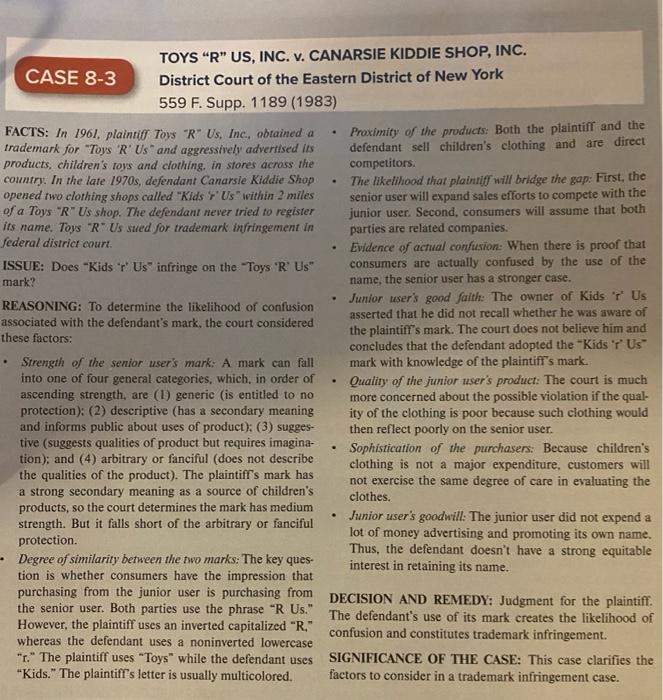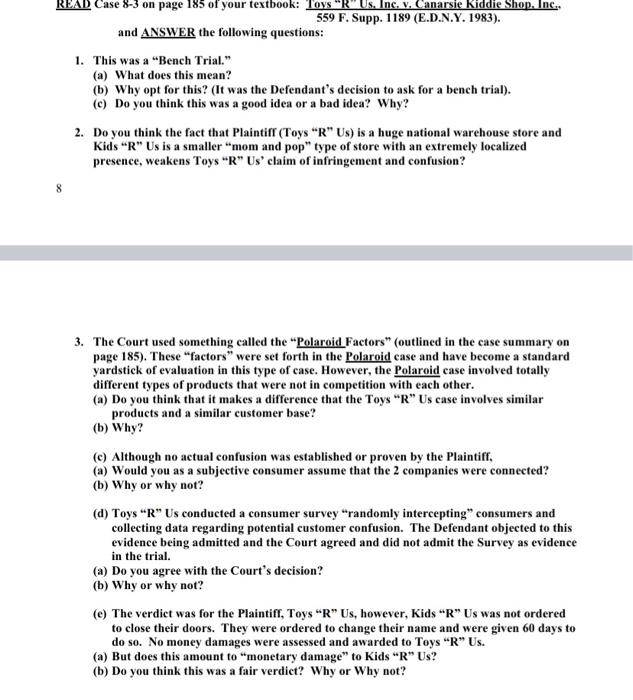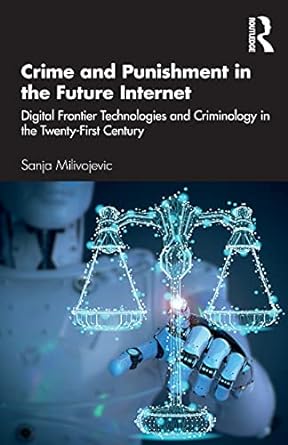. TOYS "R" US, INC. v. CANARSIE KIDDIE SHOP, INC. CASE 8-3 District Court of the Eastern District of New York 559 F. Supp. 1189 (1983) FACTS: In 1967, plaintif Toys 'R' Us, Inc., obtained a Proximity of the products: Both the plaintiff and the trademark for "Toys 'R' Us" and aggressively advertised its defendant sell children's clothing and are direct products, children's toys and clothing, in stores across the competitors. country. In the late 1970s, defendant Canarsie Kiddie Shop The likelihood that plaintiff will bridge the gap: First, the opened two clothing shops called "Kids F'Us within 2 miles senior user will expand sales efforts to compete with the of a Toys 'R' Us shop. The defendant never tried to register junior user. Second, consumers will assume that both its name. Toys"R"Us sted for trademark infringement in parties are related companies. federal district court. Evidence of actual confusion: When there is proof that ISSUE: Does "Kids 'r' Us" infringe on the "Toys 'R' Us" consumers are actually confused by the use of the mark? name, the senior user has a stronger case, REASONING: To determine the likelihood of confusion Junior user's good faith: The owner of Kids Y Us asserted that he did not recall whether he was aware of associated with the defendant's mark, the court considered the plaintiff's mark. The court does not believe him and these factors: concludes that the defendant adopted the "Kids Y' Us Strength of the senior user's mark: A mark can fall mark with knowledge of the plaintiff's mark. into one of four general categories, which, in order of Quality of the junior user's product: The court is much ascending strength, are (1) generic (is entitled to no more concerned about the possible violation if the qual- protection); (2) descriptive (has a secondary meaning ity of the clothing is poor because such clothing would and informs public about uses of product); (3) sugges- then reflect poorly on the senior user. tive (suggests qualities of product but requires imagina- Sophistication of the purchasers. Because children's tion); and (4) arbitrary or fanciful (does not describe clothing is not a major expenditure, customers will the qualities of the product). The plaintiff's mark has not exercise the same degree of care in evaluating the a strong secondary meaning as a source of children's clothes. products, so the court determines the mark has medium Junior user's goodwill: The junior user did not expend a strength. But it falls short of the arbitrary or fanciful lot of money advertising and promoting its own name. protection. Thus, the defendant doesn't have a strong equitable Degree of similarity between the two marks: The key ques- interest in retaining its name. tion is whether consumers have the impression that purchasing from the junior user is purchasing from DECISION AND REMEDY: Judgment for the plaintiff. the senior user. Both parties use the phrase "R Us. The defendant's use of its mark creates the likelihood of However, the plaintiff uses an inverted capitalized "R." confusion and constitutes trademark infringement. whereas the defendant uses a noninverted lowercase "r." The plaintiff uses "Toys" while the defendant uses SIGNIFICANCE OF THE CASE: This case clarifies the "Kids." The plaintiff's letter is usually multicolored, factors to consider in a trademark infringement case. . . . a READ Case 8-3 on page 185 of your textbook: Toys R Us Inc. v. Canarsie Kiddie Shop, Inc., 559 F. Supp. 1189 (E.D.N.Y. 1983). and ANSWER the following questions: 1. This was a Bench Trial." (a) What does this mean? (b) Why opt for this? (It was the Defendant's decision to ask for a bench trial). (c) Do you think this was a good idea or a bad idea? Why? 2. Do you think the fact that Plaintiff (Toys "R" Us) is a huge national warehouse store and Kids "R" Us is a smaller mom and pop type of store with an extremely localized presence, weakens Toys R Us' claim of infringement and confusion? 3. The Court used something called the "Polaroid Factors" (outlined in the case summary on page 185). These factors" were set forth in the Polaroid case and have become a standard yardstick of evaluation in this type of case. However, the Polaroid case involved totally different types of products that were not in competition with each other. (a) Do you think that it makes a difference that the Toys"R"Us case involves similar products and a similar customer base? (b) Why? (e) Although no actual confusion was established or proven by the Plaintiff, (a) Would you as a subjective consumer assume that the 2 companies were connected? (b) Why or why not? (d) Toys"R"Us conducted a consumer survey "randomly intercepting" consumers and collecting data regarding potential customer confusion. The Defendant objected to this evidence being admitted and the Court agreed and did not admit the Survey as evidence in the trial. (a) Do you agree with the Court's decision? (b) Why or why not? (e) The verdict was for the Plaintiff, Toys"R"Us, however, Kids R Us was not ordered to close their doors. They were ordered to change their name and were given 60 days to do so. No money damages were assessed and awarded to Toys R Us. (a) But does this amount to monetary damage to Kids R Us? (b) Do you think this was a fair verdict? Why or Why not? . TOYS "R" US, INC. v. CANARSIE KIDDIE SHOP, INC. CASE 8-3 District Court of the Eastern District of New York 559 F. Supp. 1189 (1983) FACTS: In 1967, plaintif Toys 'R' Us, Inc., obtained a Proximity of the products: Both the plaintiff and the trademark for "Toys 'R' Us" and aggressively advertised its defendant sell children's clothing and are direct products, children's toys and clothing, in stores across the competitors. country. In the late 1970s, defendant Canarsie Kiddie Shop The likelihood that plaintiff will bridge the gap: First, the opened two clothing shops called "Kids F'Us within 2 miles senior user will expand sales efforts to compete with the of a Toys 'R' Us shop. The defendant never tried to register junior user. Second, consumers will assume that both its name. Toys"R"Us sted for trademark infringement in parties are related companies. federal district court. Evidence of actual confusion: When there is proof that ISSUE: Does "Kids 'r' Us" infringe on the "Toys 'R' Us" consumers are actually confused by the use of the mark? name, the senior user has a stronger case, REASONING: To determine the likelihood of confusion Junior user's good faith: The owner of Kids Y Us asserted that he did not recall whether he was aware of associated with the defendant's mark, the court considered the plaintiff's mark. The court does not believe him and these factors: concludes that the defendant adopted the "Kids Y' Us Strength of the senior user's mark: A mark can fall mark with knowledge of the plaintiff's mark. into one of four general categories, which, in order of Quality of the junior user's product: The court is much ascending strength, are (1) generic (is entitled to no more concerned about the possible violation if the qual- protection); (2) descriptive (has a secondary meaning ity of the clothing is poor because such clothing would and informs public about uses of product); (3) sugges- then reflect poorly on the senior user. tive (suggests qualities of product but requires imagina- Sophistication of the purchasers. Because children's tion); and (4) arbitrary or fanciful (does not describe clothing is not a major expenditure, customers will the qualities of the product). The plaintiff's mark has not exercise the same degree of care in evaluating the a strong secondary meaning as a source of children's clothes. products, so the court determines the mark has medium Junior user's goodwill: The junior user did not expend a strength. But it falls short of the arbitrary or fanciful lot of money advertising and promoting its own name. protection. Thus, the defendant doesn't have a strong equitable Degree of similarity between the two marks: The key ques- interest in retaining its name. tion is whether consumers have the impression that purchasing from the junior user is purchasing from DECISION AND REMEDY: Judgment for the plaintiff. the senior user. Both parties use the phrase "R Us. The defendant's use of its mark creates the likelihood of However, the plaintiff uses an inverted capitalized "R." confusion and constitutes trademark infringement. whereas the defendant uses a noninverted lowercase "r." The plaintiff uses "Toys" while the defendant uses SIGNIFICANCE OF THE CASE: This case clarifies the "Kids." The plaintiff's letter is usually multicolored, factors to consider in a trademark infringement case. . . . a READ Case 8-3 on page 185 of your textbook: Toys R Us Inc. v. Canarsie Kiddie Shop, Inc., 559 F. Supp. 1189 (E.D.N.Y. 1983). and ANSWER the following questions: 1. This was a Bench Trial." (a) What does this mean? (b) Why opt for this? (It was the Defendant's decision to ask for a bench trial). (c) Do you think this was a good idea or a bad idea? Why? 2. Do you think the fact that Plaintiff (Toys "R" Us) is a huge national warehouse store and Kids "R" Us is a smaller mom and pop type of store with an extremely localized presence, weakens Toys R Us' claim of infringement and confusion? 3. The Court used something called the "Polaroid Factors" (outlined in the case summary on page 185). These factors" were set forth in the Polaroid case and have become a standard yardstick of evaluation in this type of case. However, the Polaroid case involved totally different types of products that were not in competition with each other. (a) Do you think that it makes a difference that the Toys"R"Us case involves similar products and a similar customer base? (b) Why? (e) Although no actual confusion was established or proven by the Plaintiff, (a) Would you as a subjective consumer assume that the 2 companies were connected? (b) Why or why not? (d) Toys"R"Us conducted a consumer survey "randomly intercepting" consumers and collecting data regarding potential customer confusion. The Defendant objected to this evidence being admitted and the Court agreed and did not admit the Survey as evidence in the trial. (a) Do you agree with the Court's decision? (b) Why or why not? (e) The verdict was for the Plaintiff, Toys"R"Us, however, Kids R Us was not ordered to close their doors. They were ordered to change their name and were given 60 days to do so. No money damages were assessed and awarded to Toys R Us. (a) But does this amount to monetary damage to Kids R Us? (b) Do you think this was a fair verdict? Why or Why not








